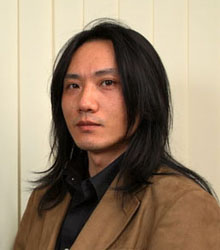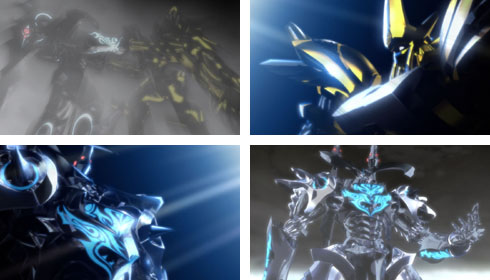A Golden Light in the Dark: The Making of Reideen CG Animation (4)
Mitsuru Hongo's Reideen inherited the DNA of Reideen the Brave, the animated classic that aired on Japanese TV between 1975 and 1976. But at the same time, it returned as an entirely new Reideen with refined mechanical designs and settings. Furthermore, the new series features high-quality 3D CG animation that was unthinkable for a TV production until now. Shigeki Hayashi and Keiji Ikeda were responsible for the modeling and VFX of Reideen and the Self Defence Police. In this forth and last part, Hayashi-san and Ikeda-san talk about, among other things, their experience in working with the two mechanical designers of the show.
 | Profile: Shigeki Hayashi - Born on January 26th in Chiba Prefecture. 3D CGI director. Board member of SimImage Studio. While still at school, he was convinced that CG was going to be the indispensable technology for the future film industry, and he decided to become a CG creator. The first creative work was to make a film that was shown at Fujitsu's pavilion at the 1990 International Garden and Greenery Exposition held in Osaka. After working for Polygon Pictures, he landed a job as lighting artist for the 3D CG movie, Final Fantasy (2001), and continued to participate in several projects including SD Gundam Force (2004, TV series, animator), in the game Monster Hunters (2004, movie part, animatics director) and Zoids: Genesis (2005, TV series, 3D CGI director). On Reideen he comments, "It was a venture to challenge the limits of 3D CG in a TV series." |
 | Profile: Keiji Ikeda - Born on October 31, 1980 in Okayama Prefecture. 3D CG VFX designer. He decided to work in the CG visuals industry because he wished to share what he enjoyed the most as a child. In 2004, he debuted as a CG designer with a TV ad for Pocket Monster Emerald (Game Boy Advance software.) Since then he has worked on Gundam Evolve (full 3D CG OVA, 2001 to 2003) and the game Monster Hunter 2 (2006). He is one of Japan's promising young CG creators. On Reideen he comments, "Yeah, it definitely was a challenging project." |
I felt the two designers were superb in determining where to concede and where to go their separate ways.
What is the proportion of the 3D parts in Reideen?
Hayashi: Talking in terms of number of cuts, we made an average of 70 to 80 cuts in 3D out of 200 and several dozen cuts per episode. Each cut is lengthy, so it's about 1/5 of the entire episode duration. Compared to all the work I'd done previously, the amount of labor for this project is enormous. But the number of cuts is not as huge as you think. It's just that the labor and toil you put into each cut is massive, so I'd say we were pretty generous in using 3D CG.
What are the challenging factors about making long cuts?
Hayashi: It would be that we constantly have to rely on the machine. And in processes including rendering and compositing (*) we have to pay more attention to details when we slow down the pace of movements. For instance, to render a quick step forward, we can just make it in a zip and it would be OK, but when the cut is longer, you raise the heel, lift the toe and THUMP! Unless you follow these steps, viewers feel like something is not right. That was one thing we had to deal with often.

By the way, Hayashi-san, you did the modeling for Reideen.
Hayashi: When I first received the model data for Reideen, I felt it was far different from the image I had from the design drawing. I wrote down everything that I felt didn't fit and showed a revised plan to Takeuchi-san. Some revisions were not necessarily essential ones. You see, in the 2D drawings, perspectives are not precisely represented, so drawings from the left and right sides would have different angles. So it's up to the person to decide which to rely on. In this sense, it would be more correct to say that I added details where I felt it necessary.
Are there special thoughts about robots that you'd like to share?
Hayashi: I am quite adamant about how they look. If the picture looks flawless, then I give thumbs up right away. But when it comes to flying objects, it's different. I retouched a little where God Bird makes a rapid flight.
How did you feel about working with Takeuchi-san and Aramaki-san?
Hayashi: Both of them were quite conscious of each other. I felt they were superb in determining where to concede and where to go their separate ways. For instance, Reideen was designed by Takeuchi-san and Gadion was designed by Aramaki-san. At the opening of Episode 1, Reideen and Gadion face each other. Gadion's concept is rather similar to Reideen's, but they are different from each other. So their designs show conflicting factors. Even then, they look comfortable on the screen together.
Aramaki-san also designed the Self Defence Police's mechs, Jinrai and Hayate. Their look is quite different from the mechanical monsters or from Reideen, as they are meant to be realistic weapons, and this is exaclty why they fit into the story concept perfectly. I think the designers respected each other and collaborated very well.

Wasn't it hard to work with two designers who were particular and persistent about their work?
Ikeda: Not really. It's actually fun to work with them. If we got an instant okay for the work done by the staff, I felt kind of disappointed.
Hayashi: Exactly. If they had okayed us straight away, I got sort of uneasy. Actually, they let us work freely to a great extent right from the storyboards. I mean we slightly changed how the camerawork was done and the motions too. We freely interpreted between the cuts, and then went ahead to work on it as much as we wanted.
Ikeda: To be honest, it was difficult in the beginning, because the storyboard would say, "cool effects" and what can you do? (lol)
Hayashi: It was like a script. We had to make up our minds what was meant by, for example, "cool," so we had meetings to pin it down.
Lastly, tell us about the must-see's in Reideen.
Ikeda: There are quite a few people who worked on the visual effects beside us. I hope viewers will pay attention to the differences among the episodes in the 3D parts, especially the visual effects.
Hayashi: We had different teams working on visual effects and each team catered to different tastes. It would certainly be fun to see these differences.
Ikeda: For example, we made some visual effects that we put in our library so that could be reused. But when we saw the finished picture, they turned out to be quite different. I think it would be more interesting to see through the episodes at how people worked hard and challenged themselves in the visual effects. You know how fans compare key animation and drawings. I hope viewers will see the difference in the 3D CG as well.
(*) Compositing is used to overlay pictures using compositing software.
(4 - end)
© 2007 Tohokushinsha Film Corporation · Production I.G

![WORK LIST[DETAILS]](/contents/works/design/images/left_title.gif)



 terms of use
terms of use